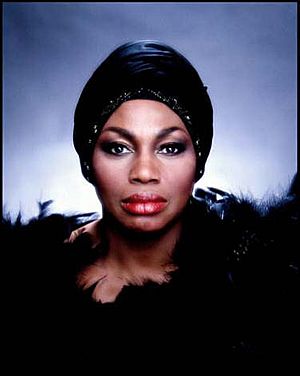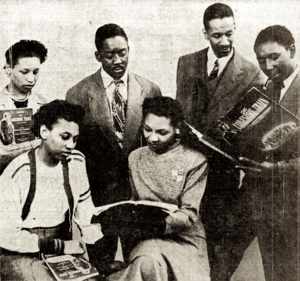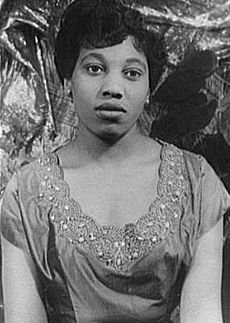Leontyne Price facts for kids
Quick facts for kids
Leontyne Price
|
|
|---|---|

A 1981 portrait of Price by Jack Mitchell
|
|
| Born |
Mary Violet Leontyne Price
February 10, 1927 Laurel, Mississippi, U.S.
|
| Education | Central State University (BA) Juilliard School |
| Occupation | Opera and concert soprano |
| Years active | 1952–1997 |
| Organization | Metropolitan Opera |
| Known for | Operas of Verdi, particularly Aida |
| Spouse(s) | William Warfield |
| Relatives |
|
| Awards |
|
Leontyne Price (born Mary Violet Leontine Price on February 10, 1927) is a famous American opera singer. She was one of the first African-American soprano singers to become a star all over the world. A soprano is a singer with a very high-pitched voice.
For many years, she was a leading star at the Metropolitan Opera in New York City, one of the most famous opera houses. She was known for her powerful and beautiful voice, especially when she sang in operas by the composer Giuseppe Verdi, like Aida.
Price broke down barriers for Black singers in the world of opera. She performed at major opera houses like the Vienna State Opera and the Royal Opera House in London. Her amazing talent and hard work made her one of the most celebrated singers of the 20th century.
After she stopped singing in operas, Price continued to perform in concerts. She has won many awards, including the Presidential Medal of Freedom and 13 Grammy Awards.
Contents
Early Life and Education
Growing Up in Mississippi
Mary Violet Leontine Price was born in Laurel, Mississippi. Her father, James, worked in a sawmill, and her mother, Katherine, was a midwife who helped deliver babies. Her family was very religious, and both of her grandfathers were ministers.
Price grew up during a time of racial segregation, when laws called Jim Crow laws kept Black and white people separate in public places like schools and restaurants. She attended schools and a church for Black people only.
Her mother was a talented singer in their church choir, and Leontyne started singing with her at a young age. Her father played the tuba in the church band.
Discovering Her Love for Music
Price began taking piano lessons when she was just three years old. When she was nine, she went on a school trip to see the famous singer Marian Anderson perform. This experience inspired her and made her want to have a career in music.
In high school, she was a cheerleader and sang in the school choir. She earned money by singing at funerals and community events. She was already becoming a popular performer in her hometown.
College and Music Training
Price went to college in Ohio at what is now Central State University. She studied music education, planning to become a teacher. However, her professors and classmates heard her amazing voice and encouraged her to focus on singing. It was during college that she changed the spelling of her first name to "Leontyne."
After college, she was accepted into the famous Juilliard School in New York City to continue her voice training. Her family and community, including a wealthy white family named the Chisholms for whom her aunt worked, helped raise money for her education. The famous singer Paul Robeson also performed in a concert to help her pay for school.
At Juilliard, she studied with a teacher named Florence Page Kimball, who helped her develop her voice from a mezzo-soprano (a lower female voice) into a soprano. Price said Kimball was one of the most important people in her life.
A Star is Born
First Steps on Stage
In 1952, while still a student at Juilliard, Price got her first big break. She was cast in a Broadway revival of an opera called Four Saints in Three Acts. This was her professional debut.
Soon after, she was cast as Bess in a major tour of the opera Porgy and Bess by George Gershwin. She toured with the show for two years, performing across the United States and Europe. The tour was supported by the U.S. government to show the world the talent of African-American artists.
While on tour, she married her co-star, William Warfield, who played Porgy. They were married from 1952 to 1973. Performing in Porgy and Bess every night taught her how to be a strong stage performer and prepared her for her future in opera.
Breaking Barriers on Television
In 1955, Price made history. She became the first African American to star in a leading role in an opera on television. She played the main character in Tosca on the NBC Opera Theatre.
This was a huge moment because millions of people saw her perform. At the time, many opera houses did not hire Black singers for major roles. Her performance was a big step in breaking down the "color barrier" in opera. Because of her success, she was offered a contract with the San Francisco Opera.
Success in Europe
Price's career took off internationally with the help of the famous conductor Herbert von Karajan. He was very impressed with her voice and helped her get roles in Europe.
In 1958, she made her European opera debut at the Vienna State Opera as Aida. She then performed the same role at the Royal Opera House in London and at the Arena di Verona Festival in Italy. Critics and audiences loved her. One critic said she was "the best all-around Aida heard in decades."
In 1960, she sang at the famous La Scala opera house in Milan, Italy. Her performance was a huge success, and she became a true international star.
The Metropolitan Opera
A Famous Debut
On January 27, 1961, Leontyne Price made her debut at the Metropolitan Opera (the Met) in New York City. She sang the role of Leonora in Verdi's Il trovatore. The performance was a massive success. The audience gave her an ovation that lasted over 35 minutes, one of the longest in the Met's history.
A critic for The New York Times wrote that her "voice, warm and luscious, has enough volume to fill the house with ease." Her debut was so important that Time magazine put her on its cover.
Price became the first Black singer to have a long and successful career as a leading star at the Met. She sang there for over 20 years, performing in 16 different roles.
Opening a New Opera House
One of the biggest moments of Price's career came on September 16, 1966. The Metropolitan Opera opened its brand new opera house at Lincoln Center. To celebrate, they asked the American composer Samuel Barber to write a new opera.
The opera was called Antony and Cleopatra, and Barber wrote the role of Cleopatra especially for Price. She starred in the world premiere on the opening night of the new Met. It was a huge event attended by famous people from all over the world. Being chosen for this honor showed how important she had become.
Later Career and Farewell
In the 1970s, Price began to perform less in operas and more in concerts and recitals. She returned to the Met for special performances, including a new production of Aida in 1976.
On January 3, 1985, she gave her final performance in an opera at the Met. She sang the role of Aida one last time. The performance was broadcast on television, and the audience gave her a 25-minute standing ovation. A critic said her singing in the famous aria "O patria mia" was "well worth the wait."
Even after retiring from opera, she continued to give concerts for another 12 years. She also wrote a children's book based on the story of Aida.
Awards and Legacy
Leontyne Price has received many of the nation's highest honors.
- Presidential Medal of Freedom (1964) - The highest award a civilian can receive in the U.S.
- Spingarn Medal (1965) - An award from the NAACP for outstanding achievement by an African American.
- Kennedy Center Honors (1980) - An award for lifetime contributions to American culture.
- National Medal of Arts (1985) - An award given by the U.S. government for artistic excellence.
- 13 Grammy Awards - More than most other classical singers.
Price's powerful voice and graceful presence on stage made her a legend. She opened doors for future generations of Black opera singers and proved that talent could overcome prejudice. She is remembered not just for her incredible voice, but also for her dignity and strength.
Images for kids
See also
 In Spanish: Leontyne Price para niños
In Spanish: Leontyne Price para niños





